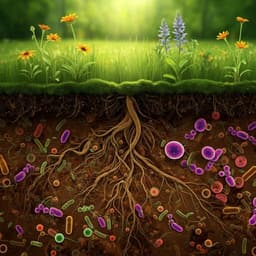
Biology
Untangling the Effects of Plant Genotype and Soil Conditions on the Assembly of Bacterial and Fungal Communities in the Rhizosphere of the Wild Andean Blueberry (Vaccinium floribundum Kunth)
A. S. D. Fossalunga, V. Cozzolino, et al.
Discover how microbial communities shape the rhizosphere of Vaccinium floribundum in the Ecuadorian Highlands! This pioneering research by Alessandra Salvioli Di Fossalunga, Vincenza Cozzolino, Dario X Ramirez-Villacis, Andrea Pinos-Leon, Pamela Vega-Polo, Isai Salas-González, Corbin D Jones, and Maria De Lourdes Torres explores the intricate interactions between plant genetics and soil factors influencing nutrient acquisition and stress tolerance.
~3 min • Beginner • English
Related Publications
Explore these studies to deepen your understanding of the subject.







